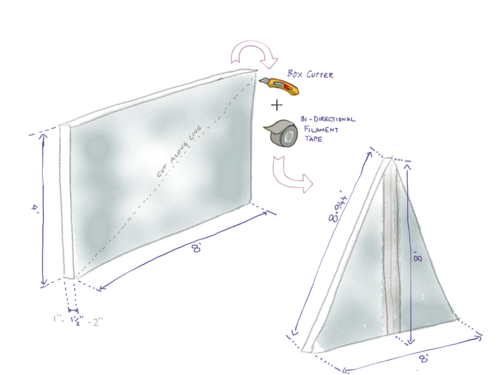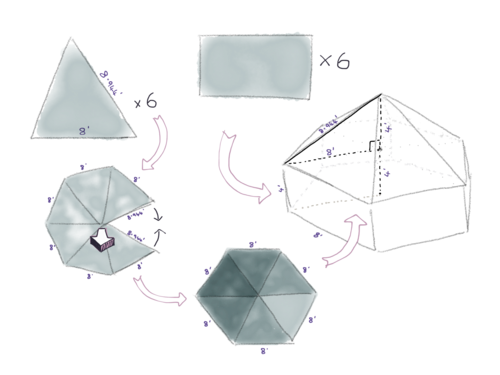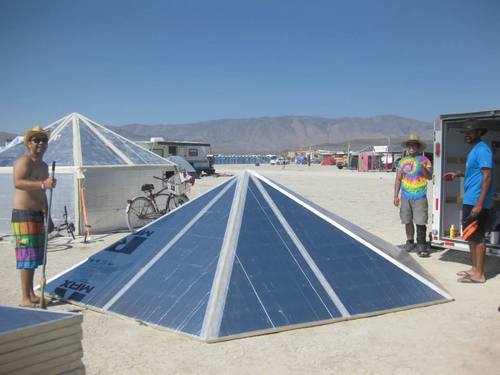Burning Man Shelter: The Hexayurt
So, you’ve decided to go to Burning Man. i.e, you are gonna go camp out in the middle of a desert for a week in dusty, dry, extreme conditions where temperatures can range from below 40°F to over 100°F, and dust storms can bring in winds up to 60 mph. A backpacker’s tent just ain’t gonna cut it for shelter! You need something way better. Something that’s sturdy which can help you stay warm at night, and most importantly, keep you cool during the day when you are most likely to sleep after partying all night – Something that is rigid, has good aerodynamics, easy to tie down to ground with stakes, is thermally well insulated, and is easy to set up and take down. In other words, you need a Hexayurt!
This dude named Vinay Gupta came up with the concept of quickly building a shelter in the desert by simply taping up insulation panels together, and built the first Hexayurt. And in recent years, it has become the primary means of shelter on the playa. So, what is a Hexayurt? This picture can give you a better idea.

Hexayurts get their name from the Hexacomb panels that were originally used, and not from their standard hexagonal layout. In fact, the construction method allows for great flexibility in design, and you can build 3-sided, 4-sided, 5-sided ones as well. Or you can get more creative with n-level geodesic domes (although I wouldn’t suggest it, as taped joints replace where the frame is supposed to be), or join yurts together to form a Hexagonal building with a courtyard in the middle. Anything you can make by cutting and taping together business cards on a desk, you can build with panels on the desert.
The only constraint is that, since tape joints are flexible, the walls can easily collapse flat (like a square collapses into a parallelogram), and need to be cross-reinforced by a roof shape that can maintain structural integrity. In the standard hexayurt shown above, it’s provided by the hex-cone roof.
For our yurts, we decided to go with the standard 6-sided design. It’s tried-and-tested, and requires minimal amount of cutting and taping together. The walls are made up of readily available 4'x8’ insulation panels (we used R-Max ThermaSheath3), and the triangular sections of the roof are made by simply cutting the same standard 4'x8’ panel diagonally, and attaching the 8’ sides together. Sorta like this:

And when you place six of them together, you get an incomplete pie (since the triangles aren’t equilateral). And pinching the open section together by pulling the central apex up, gives you the structure of the Hex-cone roof.

Here’s a picture of our roof along with our neighbors’ completed yurt in the background.

The R-Max panels that we used (and what most others used as well) were covered with silvery Aluminum foil to help deal with radiative heating using reflection (think of sunburns while snowboarding, or mylar rescue blankets in the cold), and the panels themselves had an R-Value of 9.6 to help insulate from conductive heating (think of hot air outside simply transferring heat to the air inside). We used 1.5" thick panels and felt like it struck the perfect balance between rigidity, weight, and insulation. However, people sometimes choose to go with 1" (personally found it to be too flimsy) or 2" panels, which come with different R-Values of 6.0, and 13.1 respectively.
Thermal Insulation
You may wonder what this R-Value I keep referring to is? The first time I encountered the term was at REI while shopping for Sleeping Pads, and I initially thought it was just some arbitrary marketing BS around the amount of relaxation provided. Only later did I find out that it’s actually R for Resistance, not Relaxation :)
So, what is R-Value? It’s just a unit of thermal resistance measured in:
°F•ft2•hr/Btu.
Or in layman speak, the amount in F by which the temperature between the sides of the surface need to vary by, to transfer 1 BTU of heat energy across 1 square feet of material over 1 hour. Gotta love them imperial units! :/
I will get into more detail about this R-Value math in my future post about ventilation. And I will try to do it with metric units as well! But, for now, just know that R-value is directly proportional to the amount of time it takes to heat up the insides to a specific temperature. So, lets say someone builds a yurt with R-6 material, and it takes about 5 hours for the insides to get to an undesirable temperature (assuming there’s no ventilation and there’s nobody inside, as body heat adds to the heat). A yurt built with R-9 material would take about 7.5 hours to get to the same temperature.
But I digress. Now you know what Hexayurts are. In my next post I will talk about our construction process, and the things we learned along the way.
